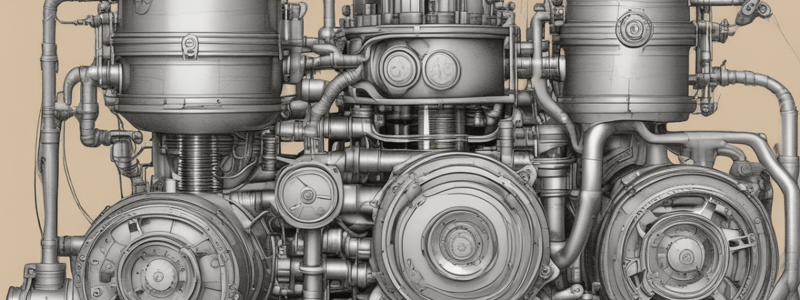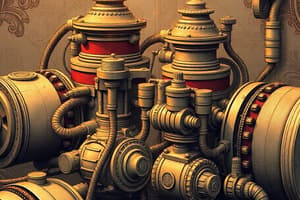Podcast
Questions and Answers
What should be done if water is found in the fuel system during inspection?
What should be done if water is found in the fuel system during inspection?
- Add more fuel to dilute the water.
- Repair the fuel strainer immediately.
- Close all drain valves immediately.
- Temporarily open all fuel drains and drain the water. (correct)
Where is the strainer drain valve control located?
Where is the strainer drain valve control located?
- Adjacent to the oil dipstick. (correct)
- On the main control panel.
- Inside the fuel tank compartment.
- Underneath the fuel tank.
What is required if the aircraft has been serviced with the wrong fuel grade?
What is required if the aircraft has been serviced with the wrong fuel grade?
- Add the correct fuel on top of the incorrect one.
- Replace the fuel strainer immediately.
- Defuel completely and then refill with the correct grade. (correct)
- Continue using the incorrect fuel until it runs out.
How often should drain plugs be removed according to the specified intervals?
How often should drain plugs be removed according to the specified intervals?
How should quick-drain valves for fuel sampling be activated?
How should quick-drain valves for fuel sampling be activated?
What happens to tire air pressure when the temperature drops?
What happens to tire air pressure when the temperature drops?
Why is it important to maintain recommended tire pressures?
Why is it important to maintain recommended tire pressures?
What primarily causes a reduction in tire pressure in cold weather?
What primarily causes a reduction in tire pressure in cold weather?
Which of the following statements is true regarding air inside a tire in cold weather?
Which of the following statements is true regarding air inside a tire in cold weather?
What should be regularly monitored to ensure vehicle safety in varying temperatures?
What should be regularly monitored to ensure vehicle safety in varying temperatures?
Flashcards are hidden until you start studying
Study Notes
Carburetor and Drain Systems
- A drain plug is installed in the carburetor to facilitate maintenance.
- Fuel tanks and fuel strainer are equipped with drain valves for easy access to fuel sampling.
Quick-Drain Valve Operation
- To activate quick-drain valves for fuel samplings, position a cup under the valve and press the valve with a rod that extends from the cup.
- Refer to Section 12 for a visual illustration of the fuel tank drain valve.
Strainer Drain Valve Features
- The strainer drain valve is integrated into the fuel strainer assembly, enhancing design efficiency.
- A control for the strainer drain is situated near the oil dipstick for straightforward operation.
- Access to the strainer drain control is available through the oil dipstick access door.
Maintenance and Inspection Protocols
- Open drains and remove drain plugs at specified intervals as detailed in figure 2-4 to ensure system integrity.
- During daily inspections of fuel tanks and strainer, check for water presence; if found, temporarily open all fuel drains to eliminate water.
Fuel Quality and Management
- Complete defueling is necessary if the aircraft has been serviced with an incorrect fuel grade, followed by refueling with the correct grade.
- To maintain proper operation, fuel tanks should be kept filled between flights, provided weight and balance considerations allow it.
Fuel System Maintenance
- Drain plug is located in the carburetor, essential for system maintenance.
- Fuel tanks and strainer are equipped with drain valves for effective management of fuel quality.
- Quick-drain valves can be activated for fuel samples by positioning a cup and pressing the valve with a rod.
- Strainer drain valve is integrated into the fuel strainer assembly and is vital for ensuring clean fuel flow.
Access and Controls
- Strainer drain control is situated next to the oil dipstick, accessible through the dipstick access door for convenience.
- Periodic draining and removal of plugs should occur according to specified intervals outlined in reference material.
Daily Inspection Protocol
- During daily inspections, any water detected in the fuel system necessitates the immediate opening of all fuel drains to remove contaminants.
- If defective or incorrect fuel grade is used, a complete defueling is required, followed by refueling with the correct grade.
Fuel Management Recommendations
- Keeping fuel tanks full between flights is advisable, provided weight and balance are appropriate.
- Maintaining recommended tire pressures is crucial, impacting aircraft performance and safety.
- Cold weather considerations: A decrease in air temperature leads to reduced tire pressure, necessitating regular checks.
Studying That Suits You
Use AI to generate personalized quizzes and flashcards to suit your learning preferences.




